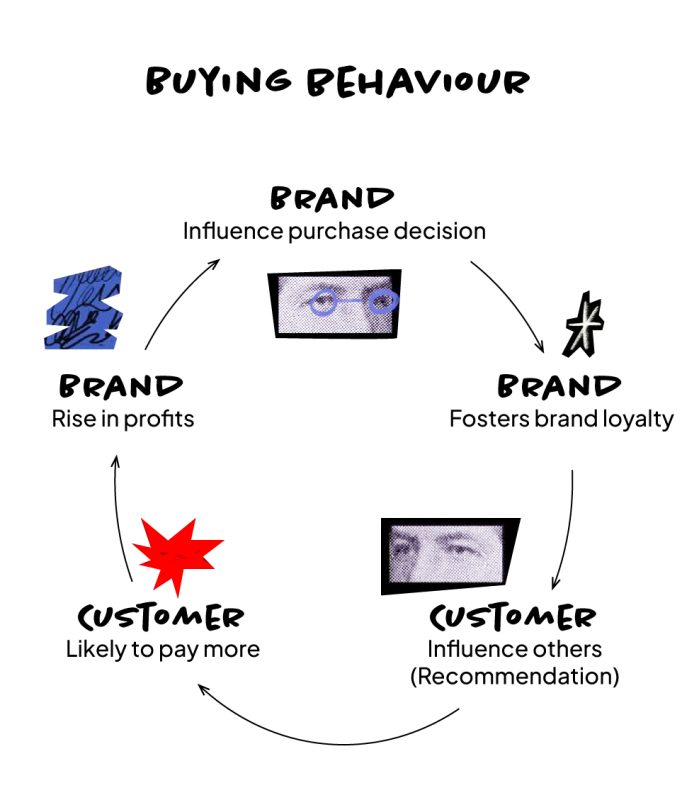
08/23 | Opinion
How Branding Impacts Customer Behaviour
“A brand for a company, is like a reputation for a person”
Jeff Bezos, CEO Amazon
92% of consumers trust recommendations from family and friends. That’s a powerful statistic which demonstrates the influence of human behaviour.
Plus, 72% of customers who have a positive experience with a brand are likely to share that experience with 6 people.
On the flip side, 13% of customers who had a negative with a brand are likely to share with 15 people.
So how to become a brand that delivers positive experiences only, in such a busy and competitive environment? You have to understand the connection between branding and customer behaviour!
Understanding the Elements of Branding
There are a few elements of branding that come together to impact customer behaviour:
Brand Image: The physical appearance of a brand; logos, colours, slogan.
Brand Values: The key principles guiding how your company operates.
Brand Awareness: Are customers aware of your brand and your brand values?
Brand Perception: How a customer feels about your brand.
Brand Equity: The commercial value that comes from consumer perception of the brand, rather than from the product or service itself.
Brand Loyalty: The accumulation of a positive brand experience that results in a customer returning to your brand for repeat purchases and trying other products in your range.
Understanding Your Customer
As consumers, we make decisions that align with our personal tastes, preferences and values. We build relationships with brands that reflect our values. So it’s essential that brands understand their target audience and align with their customer’s values, focusing on the value they will add to their customers’ lives.
Trust comes from strong branding and positive customer experiences. Branding shapes the customer’s perception of attraction and familiarity.
It’s important for brands to understand and measure brand perception among their target market. This can be achieved through surveys, monitoring social media interactions, and brand tracking studies.
The more a brand understands its customers the more it can highlight its brand personality to connect with those customers and promote its extrinsic values.
Effects on Buying Behaviour
When strong branding meets with the values of the target audience we start to see the impact on buying behaviour.

Examples of Branding Impacting Customer Behaviour
Brand Loyalty – Apple
Apple customers are so loyal they will be queuing outside the store on the release day of a new product. A study conducted in 2021 revealed that 92.6% of iPhone users are planning to stick with Apple for their next phone, compared to just 74.6% of Samsung users.
Apple focuses on the value their products add to people’s lives and connections. They make life easier, they are fun. They are promoting a lifestyle and a positive experience that customers return for again and again. All of this is without any pricing in their marketing.
Customer Centred – Nike
Nike is the leading sports brand and became so by selling their values rather than their products. Nike’s marketing strategies have changed and adapted over the years, but consistently they always remain customer focussed. They help their customers become better athletes and empower and motivate them.
They focus on the benefits their products can have for their customers rather than the features of the products.
And it works.
Nike is reported to sell 26 pairs of shoes every second. And their marketing has been so successful they made a film about the Nike Air Jordan campaign starring Matt Damon and Ben Affleck.
Changing Expectations – Amazon
Amazon has changed the way consumers shop with fast and free delivery. In what is coined as “The Amazon effect”, customers now expect the same level of service from other brands as standard. Other brands have had to raise their game to compete with the juggernaut that is Amazon.
User-Generated Content – Netflix
With word-of-mouth marketing and recommendations being such a huge part of a customer’s purchase decision, it’s worth taking note of brands that excel in attracting user-generated content. Netflix has made their brand part of everyday conversation with ‘Netflix and chill’ being a commonly used phrase.
Netflix creates a buzz around a new series release and consumers create their own authentic content recommending a Netflix series to their followers. When Netflix trialled a teaser for the second series of their hit show Stranger Things, users shared strange things that had been happening to them with the hashtag #strangerthings2. There are over 2 million pieces of user-generated content on Instagram with this hashtag. That’s a lot of free advertising.
Conclusion
When branding connects with a customer’s values it creates recognition and trust with the customer. When that leads to a purchase decision with a positive experience it can lead to recommendations and brand loyalty. In really well-executed branding campaigns, it can even change customers’ behaviour.
Branding can heavily impact and influence customer behaviour. Ultimately, branding is the difference between a customer choosing your brand or a competitor.
Get in touch with us today if you are considering a rebrand or strengthening your existing brand for a better customer experience!
